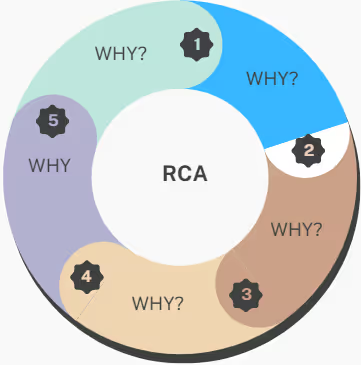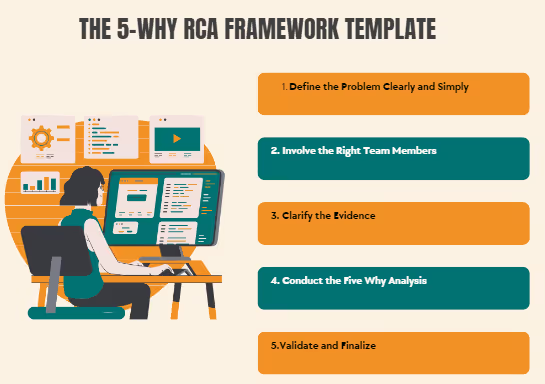As Anthony J. D'Angelo said, “When solving problems, dig at the roots instead of just hacking at the leaves.”**
Whenever an incident occurs that impacts customers or affects revenue, performing a Root Cause Analysis (RCA) becomes essential for identifying the underlying cause of the problem. RCA reports document these incidents in detail, serving as a reference for future cases, improving transparency, and fostering a culture of learning within engineering and business teams. These reports are crucial for preventing recurring issues and building better systems.

The 5-Why framework, a specific method within RCA, was popularized by Taiichi Ohno as part of the Toyota Production System. It encourages a structured problem-solving approach by repeatedly asking “why” five times to trace back to the fundamental cause of a problem.
Why+Why+Why+Why+Why=5 Why
This method helps teams move beyond superficial explanations, digging deeper into operational issues and finding lasting solutions.
In this blog, we will explore how the 5-Why framework can help in conducting effective RCAs and building stronger processes.
The 5-Why RCA Framework is a widely recognized and effective method for uncovering the root causes of issues and ensuring long-term solutions. The framework maximizes clarity by simplifying the root cause and assigning clear ownership of the actions needed to prevent similar incidents in the future.

Here’s a breakdown of the template used in this approach:
Start by concisely defining the problem. The goal is to have a clear understanding of what went wrong, described in simple terms that everyone on the team can understand. This step ensures that everyone is aligned before the analysis begins.
The analysis requires participation from team members who are deeply familiar with the incident and can provide insight into the technical aspects. Having the right people in the room ensures that the analysis delves into the technical depths of the issue, leaving no stone unturned.
Gather all the data and evidence related to the incident, such as logs, metrics, and any immediate fixes applied. This evidence will form the foundation for understanding the issue and supporting each answer in the subsequent 5-Why analysis.
This is the core of the process. Start by asking the team a fundamental question: "What caused this issue to occur?"
Once the 5-Why process is complete, confirm that the root cause identified can indeed prevent the problem from recurring if corrected. Ensure that action items are clearly defined and assigned to team members and include timelines for implementation.
By following this structured template, teams can effectively get to the core of incidents and ensure long-term solutions are implemented rather than relying on short-term fixes. The 5-Why RCA Framework drives thorough investigation and accountability within teams, preventing similar incidents from happening again.
Root Cause Analysis (RCA) is an essential process that allows teams to investigate incidents, identify underlying causes, and implement long-term solutions. In this section, we'll explore some key benefits of RCA and how it strengthens team dynamics and system reliability.
1. Identifies Human Errors
RCA helps identify human mistakes that contributed to incidents, offering insights into how these errors can be minimized through better training, clearer processes, or automated solutions.
2. Promotes Team Ownership
The process encourages team members to take responsibility for their role in the incident, fostering a sense of ownership and accountability when it comes to resolving and preventing similar issues.
3. Prevents Recurrence of Issues
By addressing the core issue rather than just the symptoms, RCA ensures that long-term solutions are implemented, significantly reducing the likelihood of the problem occurring again.
4. Improves System Reliability
RCA uncovers deeper problems within systems, allowing teams to address inefficiencies and improve overall system performance and reliability.
5. Facilitates Continuous Learning
Each RCA helps the team learn from mistakes, encouraging a culture of continuous improvement. Teams can adapt processes and solutions to enhance performance based on past incidents.
6. Encourages Cross-Team Collaboration
RCA often requires input from various departments, leading to better communication, understanding, and collaboration across the organization as they work toward a common goal.
7. Supports Data-Driven Decision Making
RCA relies on factual evidence such as logs, metrics, and analytics. This data-driven approach leads to more informed decision-making and ensures that corrective actions are based on real insights, not assumptions.
.avif)
The above-mentioned benefits make RCA a powerful tool for improving operational efficiency, reducing errors, and fostering a proactive problem-solving culture within any organization.
Root Cause Analysis (RCA) is a highly effective method for identifying underlying issues, but like any approach, it comes with its own challenges. Below, we’ll explore one of the common obstacles that teams may face while conducting RCAs.
1. Unsolvable Root Causes
Sometimes, the RCA process reveals a root cause that cannot be realistically solved. This may stem from broader systemic issues, technological limitations, or external factors beyond the team's control. In such cases, while the issue is well understood, the ability to address it might be limited, leading to frustration and the need to find workarounds or mitigations.
2. Incomplete Data Collection
Gathering accurate and complete data is critical for RCA, but teams often lack access to all relevant logs, metrics, or records. Incomplete or missing data can lead to incorrect conclusions and prevent the true root cause from being identified.
3. Confirmation Bias
Investigators may focus on symptoms that align with their initial assumptions or experiences, overlooking the actual root cause. This bias can skew the analysis and lead to premature conclusions without fully exploring other possibilities.
4. Focusing on Symptoms, Not Causes
Teams may be tempted to resolve immediate symptoms rather than investigating deeper, underlying causes. This can result in recurring issues as the fundamental problem remains unresolved.
5. Time Constraints
Performing a thorough RCA takes time, but high-pressure environments often demand quick fixes. This urgency can result in incomplete analyses and less effective long-term solutions.
6. Complexity of Systems
Modern IT infrastructures are highly complex, with many interconnected components. Identifying the root cause within these complicated systems requires careful analysis, and any overlooked element can lead to misdiagnosis.
Root Cause Analysis (RCA) using the 5-Why Framework is a powerful method that empowers teams to get to the heart of complex problems. By repeatedly asking "why" and digging deeper into incidents, teams can uncover the true cause of issues, leading to more permanent and effective solutions. This structured approach not only helps prevent future incidents but also fosters a culture of transparency, continuous improvement, and accountability within organizations.
While RCA offers significant benefits such as improved system reliability, enhanced team collaboration, and data-driven decision-making, it is important to be mindful of challenges such as identifying root causes that may be beyond immediate resolution. However, by leveraging frameworks like the 5-Why method, teams can ensure a thorough and efficient problem-solving process that drives long-term operational success.
Implementing RCA as part of your incident management strategy can greatly improve your team's ability to handle critical incidents, enhance system performance, and create a more resilient organization.
Try Doctor Droid — your AI SRE that auto-triages alerts, debugs issues, and finds the root cause for you.
(Perfect for DevOps & SREs)

Install our free slack app for AI investigation that reduce alert noise - ship with fewer 2 AM pings
Everything you need to know about Doctor Droid
The 5-Why framework is a problem-solving method popularized by Taiichi Ohno as part of the Toyota Production System. It involves repeatedly asking "why" (typically five times) to trace back from a surface problem to its fundamental underlying cause. This structured approach helps teams move beyond superficial explanations to identify and address the true root of operational issues.
You should conduct a Root Cause Analysis whenever an incident occurs that impacts customers, affects revenue, or disrupts critical services. RCAs are essential after significant outages, security breaches, performance degradations, or any incident that warrants understanding to prevent recurrence and improve system reliability.
The main benefits include: identifying underlying causes rather than symptoms; preventing recurring issues; improving system reliability; enhancing team collaboration and knowledge sharing; creating documentation for future reference; fostering a culture of learning; and enabling data-driven decision-making for process improvements.
Start by clearly defining the problem. Then ask "why" the problem occurred and document the answer. For each answer, ask "why" again until you've reached approximately five levels deep or uncovered the fundamental cause. Document each level, involve relevant stakeholders, and focus on processes and systems rather than blaming individuals.
A good RCA report should include: incident details (timing, duration, impact); problem statement; the chain of 5-Why questions and answers; root cause identification; contributing factors; corrective and preventive actions; implementation timeline; verification methods; and lessons learned.
Common challenges include: jumping to conclusions before thorough investigation; stopping at symptoms rather than identifying true root causes; lack of cross-functional participation; encountering root causes beyond immediate resolution capabilities; confirmation bias in the investigation; and failing to implement corrective actions after the analysis.
While the 5-Why framework is versatile, it works best for straightforward incidents with clear cause-and-effect relationships. For more complex, systemic issues with multiple contributing factors, you might need to combine it with other RCA methods like Ishikawa diagrams (fishbone), fault tree analysis, or change analysis to get a comprehensive understanding.
Focus on identifying process and system failures rather than individual mistakes. Establish a blameless culture where the goal is learning, not punishment. Emphasize that human error is usually a symptom of underlying system problems. Use neutral language in reports and discussions, and ensure leadership demonstrates that RCAs are about improvement, not finding scapegoats.
Dr. Droid can be self-hosted or run in our secure cloud setup. We are very conscious of the security aspects of the platform. Read more about security & privacy in our platform here.
Dr. Droid can be self-hosted or run in our secure cloud setup. We are very conscious of the security aspects of the platform. Read more about security & privacy in our platform here.


